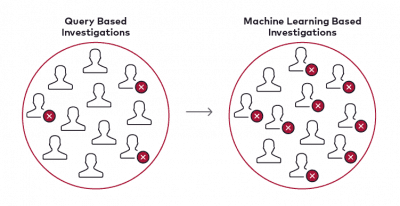Recent years have seen an explosion of consumer products that incorporate artificial intelligence (AI). Self-driving cars, Alexa, Siri, chatbots, Google search, and smart traffic lights are examples of how artificial intelligence is impacting the world. While artificial intelligence has gained mainstream attention recently, AI applications have been “hidden” for many years in a variety of business applications, such as credit scores, credit card fraud detection, direct marketing, and more.
Retail loss prevention has also seen applications of AI in technologies such as facial recognition and return fraud authorization. In this article, we extend the loss prevention professionals’ toolkit and show the results of a machine-learning algorithm (a specific type of AI) developed to detect fraudulent and abusive employee activity.
The ultimate objective for developing machine-learning models is to obtain collective intelligence to curb employee deviance. Appriss Retail serves more than ninety retailers worldwide, and this experience provides a solid foundation for such model development.
From Rules and Queries to Predictive Models and Machine Learning
Today, most loss prevention departments use traditional exception-based reporting (EBR) tools to monitor their employees by running queries on point-of-sale data that flags suspicious activities. EBR tools used by retailers are similar to the tools used by the credit card industry in the 1980s to detect fraud. In the early 1990s, the credit card industry mostly abandoned the EBR approach in favor of methods of detection based on predictive modeling and machine learning. A similar trend was seen with health-care fraud about fifteen years ago. Our prediction is that retail loss prevention will evolve in a manner comparable to credit card fraud detection.
In a traditional EBR process, a query is run to look for anomalous behavior, and its output is provided to an analyst in the form of a list of transactions or employees to investigate. Then the analyst or investigator reviews the exceptions presented and determines, sometimes based on looking at additional information, if the transaction or employee in question warrants further review. Some of the exceptions will result in an action against the employee, such as arrest or termination of employment, which we label as “success” in the flow chart below.

The goal of machine learning is to apply a complex mathematical model to the data and learn, using thousands of variables, the most useful elements in an employee’s transactions for identifying cases that are most likely to result in an action. With a machine-learning model, the top-ranked exceptions will have a much higher rate of success than those that are generated from traditional EBR. Over time, an approach with a higher success rate will make loss prevention departments far more efficient and will decrease employee fraud rates.
Overview of Artificial Intelligence and Machine Learning
Artificial intelligence can cover a wide range of tasks. The next diagram illustrates some frequently used components of AI.

Predictive Models and Machine Learning. Predictive models and machine learning are shown in the diagram as almost completely overlapping circles and are very close in definition and purpose. The primary difference between the two is machine learning originated in computer science, whereas predictive modeling was developed in the field of statistics. In the past decade or more, the two fields have essentially merged and now share a highly overlapping definition. Both are concerned with using data to predict or model outcomes, and both are tools used in AI.
Deep Learning. Deep learning is a process that uses highly complex model structures to learn patterns in the raw data without any human intervention, thus eliminating the need for derived variables. The difficulty in deep learning is that the more complex models are often more difficult to fit accurately.
Dynamic Learning. There are two very different types of model categories: static models and dynamic models. A static model is fit to a static pattern in data. The predictions from a static model can change as the data it is presented with changes, but if the model is presented with the same exact data, it will produce the same exact answer. By contrast, a dynamic model’s prediction can change from day to day even if it is presented with the same information. Dynamic learning is a process by which models are refit or updated dynamically as new data presents itself. This approach is useful when a system is continually bombarded with additional information and the relationships in the data are dynamic and the model itself needs to change to adapt.
Collective Intelligence
Machine-learning models allow developers to use data from many retailers to create a more powerful solution, and Appriss Retail’s worldwide retailer base is a significant benefit. Each retailer is unique in the exception-based approaches and investigation techniques that result in employee terminations and prosecutions. Combining retailer strategies leads to better detection, including:
- Variables resulting from shared questions
- Models built on many successful strategies
Using Dynamic Learning and Feedback
Beyond the collective-intelligence model described in the prior section, a final objective of an AI-based employee-deviance detection system is a feedback loop from the investigations back into the models. During an investigation, the investigator will perform many actions that can be captured in a system and later used to improve system accuracy. For example, the investigator will click on related transactions and individuals, will open a case, will abandon a case or a transaction, and so on. The captured usage activity can be converted into information that a machine-learning model can utilize to improve the models. This type of feedback loop ensures that as new fraud schemes are detected at one retailer, that pattern is captured in a broader model that propagates across all retailers.

The Ultimate Objective
As stated above, the ultimate objective for developing machine learning models is to combine many learnings and obtain collective intelligence to curb suspicious employee behavior. In this application of machine learning, a department store chain saw at least a 25 percent increase in fraud-related terminations above what would normally be captured by EBR alone. Visit apprissretail.com to learn more.



